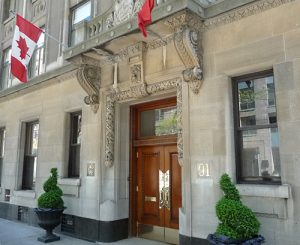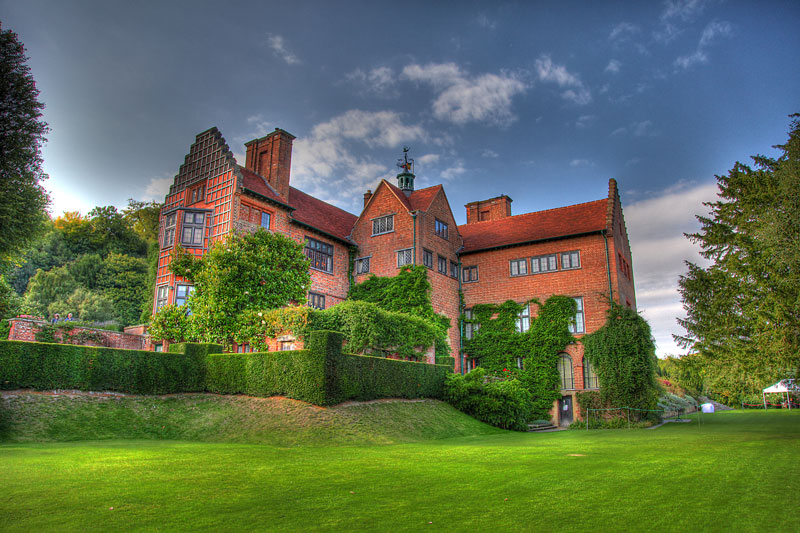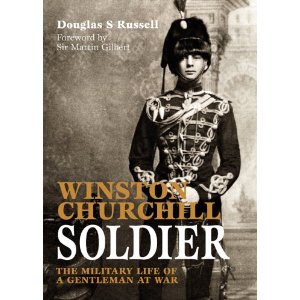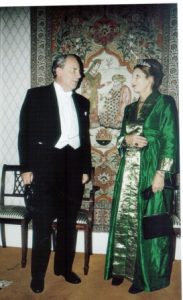
Bulletin #36 - Jun 2011
A Visit with the New House Manager at Chartwell

Chartwell, Westerham, Kent
June 8, 2011
May 2011
Churchill Centre Executive Director Lee Pollock recently visited Chartwell, the Churchill family home in Kent, and met with the new House & Collections Manager, Alice Martin. In this CB interview, Alice talks about her background and some of the new initiatives she’s planning for this great and historic home.
Alice, CB’s readers would be interested in learning more about your background. How did you first become involved with museums and historic homes? Was it an interest of yours when you were growing up or part of your education later on? (And any “Churchillians” in your family?)
I have always had a fascination with history and museums from when I was a very small child and grew up on dreams of being Indiana Jones. I had a peripatetic upbringing coming from a diplomatic family with the one constant in whatever madcap country we were stationed being the cool calm of a museum. Having wanted to work in museums since a very early age I completed a Classics degree followed by a Masters in Museums Studies. I then worked for five years at the Imperial War Museum before running a museums service down on the Southwest coast of England. No Churchillians in my family sadly, although my great grandparents met and married whilst living in a stately home – but they were strictly below stairs!

2024 International Churchill Conference
Tell us about your experience at other organizations prior to coming to Chartwell. How do you think that will help in your new responsibilities?
Running a museum service in the hard times that have hit British independent museums over the last 10 years certainly honed my resourcefulness. I love practical day to day tasks as well as the more academic side of heritage work. This is lucky as every day brings some new challenges from trips and falls, the state of the guttering, academics wanting to know when Churchill had tea on a specific day to the mortar used on a particular section of a wall. I also have an unending love of original objects and truly adore museums collections – I am regularly reminded that I actually cried when I first held Churchill’s passport.
How did you find out about the opportunity at Chartwell and what attracted you to it?
I was actually looking for a job for one of my staff who had come to work for me on a traineeship when I spotted the position on the Trust’s jobsite. The chance to work at such a unique and beautiful place was just too good to pass up. My early work at the Imperial War museum had consolidated an interest in Churchill gained from previous study and it was a great opportunity to explore this further. It was very fortuitous as I spotted the post 2 days before the closing date.
While many of our readers have visited Chartwell, some have not. Could you give us a brief overview of Chartwell’s history, the major parts of the home and estate and some of the highlights that visitors seem especially drawn to. What time period in Churchill’s life does the house represent?
Chartwell was Sir Winston’s family home from the 1920’s through to his death in 1965 although he spent most of his last year in London. The records office first note of Chartwell dates back to 1362 and the house we know today started life as a Tudor building with the beams still seen in the study dating back to around 1545. It was more than likely a building of high status as it had four stories which was quite rare for the time.
Like most English country houses Chartwell has had many owners keen to put their own stamp on it and each resident family seems to have done just that. The main alterations were done in three distinct periods. The 18th century when the building doubled in size and was made into a permanent dwelling. In 1848 when the house passed to the Campbell Colquhouns and was extended twice with 815 acres of surrounding land bought and developed. Its final incarnation was the sprawling Victorian house with 80 acres of garden surrounding it that Sir Winston viewed and fell in love even though it was a wreck at the time. It should also be said that he bought it without first telling his wife – an eventual conversation I would love to have overheard.
After purchase Sir Winston hired the architect Philip Tilden to make it into a modern family home; the extensive alterations took two years and created the house you see today. This includes the prominent garden rooms at Chartwell that make the most of the stunning views across the Weald of Kent. The many features of the house highlight the Churchill family’s interests and preferences and the bright airy rooms and décor reflect Clementine’s taste. There is a large study where Sir Winston spent his working hours writing to supplement the family’s finances. The garden with its croquet lawn, Marycot (Mary’s Wendy house), ponds and of course Sir Winston’s studio where he spent many hours painting. Today visitors see the house as it was laid out by Lady Clementine and her daughter Mary Soames and it reflects how the rooms were used in the house’s hey day of the 1920s and 30s.
Are you open year around? How many visitors do you have in a typical year and what countries do they come from? How does Chartwell compare to other National Trust properties in popularity and recognition?
Chartwell is a ‘flagship’ property and is therefore among the National Trust’s most visited. The garden and studio are open all year round and we are aiming to get over 200,000 visitors this year; we were only just under that total last year. In 2011 the Exhibition room (the last room on the house tour) will also be open all year round as we are in the process of an exciting new project to renovate this space. This will create a new biographical exhibition on Churchill as well as developing the space for annual three month temporary displays during the winter months where we can showcase the many treasures we hold in reserve. We hope to be able to tour these temporary displays and borrow and lend to other Churchill venues both at home and abroad
Our visitors are made up of approximately 80% members to 20% payers, also the same split of British visitors to overseas visitors. Visitors come from all over the world including many from your shores over the pond
What are some of the challenges of operating such a popular attraction, especially in maintaining and preserving the home and its contents? Is it true you can only show part of the overall collection at any one time?
Where do I begin! For much of the summer months we are running at 60 people every 15 mins entering the house. The sheer weight of numbers on the floors, brushing the walls, touching the glass, and most tellingly the huge the amount of dust and grit keeps us busy in conservation terms. All items in the house are original to the Churchill family and therefore irreplaceable should they suffer irreparable damage. Light is also an enemy we are constantly battling. Churchill loved this house for the views and light and to remain true to this we try to be as generous as possible with the light levels, which is another reason we have to rest the house during our closed season. The gardeners similarly battle to keep the lawns, paths and plants looking good and answer the multiple questions posed by the thousands of keen gardeners who visit the property. The Restaurant turns around each of their 200 seats at least 5 times during any given day and serve over 75,000 cups of tea and coffee and a whopping 31,00 cream teas a year.
Has Chartwell changed much in recent years? What plans do you have in the future for exhibitions, new educational programming and other initiatives?
The property is always changing as we cater for more and more visitors and grow our offer. Over the next year we are starting to make available our collection online so remote users can view, not only what is on display, but also the items we hold in reserve. This outward-looking approach is also reflected in our wish to further increase items we loan to other museums and Churchill organisations. We hope our three months travelling exhibitions will be key in facilitating this and I am in the early stages of planning an exhibition to bring together the treasures of the Big Three – Churchill, FDR and Stalin. A starting point for this is a gift given to Churchill and his fellow leaders at the Teheran Conference. These exquisite ivory and oil miniatures by Haji Musavir done in the 17th-century manner represent the pursuit of the Axis leaders by Roosevelt, Stalin, WSC and Chiang Kai Shek and will hopefully form the centre of an exhibition we can tour in the UK, US, Russia and China.
Is it true you get to live “above the store”? On dark and stormy nights, do you ever start hearing echoes of the past – or even seeing them?
Yes, I am extremely lucky to live in a suite of rooms on the top floor of the house which has a lovely atmosphere as you would expect from such a famous family home. I also think it would be very hard to feel unsafe atop a house with over 7600 security and fire sensors – you only have to singe a piece of toast or open the wrong door for the police or fire brigade to turn up! It is a very fine address to hold though and a recent highlight includes completing the 2011 UK census – what will my descendants think!
Churchill was a great cat lover. Tell us about Jock and the feline “tradition” at Chartwell?
Ahh, the cat – Jock the 5th whose lives with me in the roof (no mad lady in the attic jokes please) is part of a long tradition of Marmalade cats at Chartwell which includes Tango who you can see on the breakfast table in the painting by Nicholson in the dinning room here at Chartwell. Jock the 1st was the last of Churchill’s ginger cats and survived Churchill by several years. It was Churchill’s wish that there was always a home for a marmalade cat with white paws and bib at Chartwell – and I am more than happy to continue the tradition. He is a great favorite with the visitors and a media darling to boot having been on both the ITV and the BBC as well as in many national and international newspapers.
Lastly, even though you’re new at Chartwell, have you developed some personal “favorites” you especially enjoy? What are three “must see” things every visitor should see?
Truly stunning views and Gardens
1st flag raised in a liberated European capital – A Union flag raised in Italy after the Landings of September 1943
American Citizenship signed by JFK
Chartwell is located approximately 30 minutes by train from London. More information including opening times is available on their website. Tel +44 (0)1732 868381 Email [email protected]
Follow this link for a full list of all Churchill’s residences.
Subscribe
WANT MORE?
Get the Churchill Bulletin delivered to your inbox once a month.




